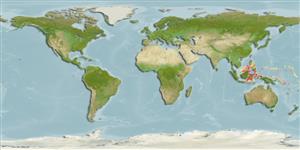分類 / Names
俗名 | 同種異名 | Catalog of Fishes(屬, 種) | ITIS | CoL | WoRMS | Cloffa
Teleostei >
Acanthuriformes (Surgeonfishes)
鱸形目 (Surgeonfishes) >
Pomacanthidae (Angelfishes)
刺蓋魚科 (Angelfishes)
Etymology: Centropyge: Greek, kentron = sting + Greek, pyge = tail (Ref. 45335); abei: Named for Dr. Yoshitaka Abe, Aquamarine Fukushima..
Environment: milieu / climate zone / depth range / distribution range
生態學
海洋 居於水底的; 深度上下限 110 - 155 m (Ref. 90102).
Western Pacific: Indonesia and Palau.
大小 / 重量 / 年齡
Maturity: Lm ? range ? - ? cm
Max length : 9.1 cm SL 雄魚/尚未辨別雌雄; (Ref. 77035)
簡短描述
型態特徵 | 形態測量圖
背棘 (總數): 13; 背的軟條 (總數): 17; 臀棘 3; 臀鰭軟條: 18; 脊椎骨: 24. This species is with the following set of characters: D XIII, 17; A III,18; pectoral rays 16; relatively large scales, 43-45 in lateral row from upper end of gill opening to base of caudal fin; 37 lateral line scales, terminating below end of dorsal fin and re-appearing on 7 scales of caudal peduncle; gill rakers on first arch 5 + 12; maximum body depth 1.6 in SL; 3 or 4 preopercular spines; length of primary preopercular spine 2.0 in head length; tricuspid teeth, about 50-60 in outer row in each jaw; exposed margins of preorbital, interopercle, preopercle,
subopercle, supracleithrum, and posttemporal bones serrate; posterior margin of preorbital bone attached and hidden by skin and scales; color in life yellow with black upper third of back, dorsal fin, and upper part of head; a broad white bar immediately anterior to dorsal fin origin, extending to at least level of upper opercular margin; white caudal fin and peduncle (Ref. 77035).
Found over bottom that is primarily composed of variably sized rubble, with temperature 20-21°C (Ref. 77035).
Life cycle and mating behavior
成熟度 | 繁殖 | 產卵場 | 卵 | 孕卵數 | 仔魚
Allen, G.R., F. Young and P.L. Colin, 2006. Centropyge abei, a new species of deep-dwelling angelfish (Pomacanthidae) from Sulawesi, Indonesia. aqua, J. Ichthyol. Aquat. Biol. 11(1):13-18. (Ref. 77035)
人類使用
更多資訊
俗名同種異名新陳代謝捕食者生態毒物學繁殖成熟度產卵場產卵群集孕卵數卵卵發育
年龄/大小成長長度-重量長度-長度長度-頻率形態測量圖型態特徵仔魚稚魚動力學入添量豐度BRUVS
參考文獻養殖養殖資訊品種遺傳學Electrophoreses遺傳率疾病加工NutrientsMass conversion
合作者照片Stamps, Coins Misc.聲音神經毒速度泳型鰓區Otoliths腦重體重比眼睛色素
工具
特別的報告
下載 XML
網路資源
Estimates based on models
Preferred temperature (Ref.
123201): 17.9 - 22.6, mean 18.8 °C (based on 7 cells).
Phylogenetic diversity index (Ref.
82804): PD
50 = 0.5000 [Uniqueness, from 0.5 = low to 2.0 = high].
Bayesian length-weight: a=0.03090 (0.01359 - 0.07026), b=2.89 (2.70 - 3.08), in cm total length, based on LWR estimates for this (Sub)family-body shape (Ref.
93245).
營養階層 (Ref.
69278): 2.8 ±0.3 se; based on size and trophs of closest relatives
回復力 (Ref.
120179): 中等的, 族群倍增時間最少 1.4 - 4.4年 (Preliminary K or Fecundity.).
Fishing Vulnerability (Ref.
59153): Low vulnerability (10 of 100).
